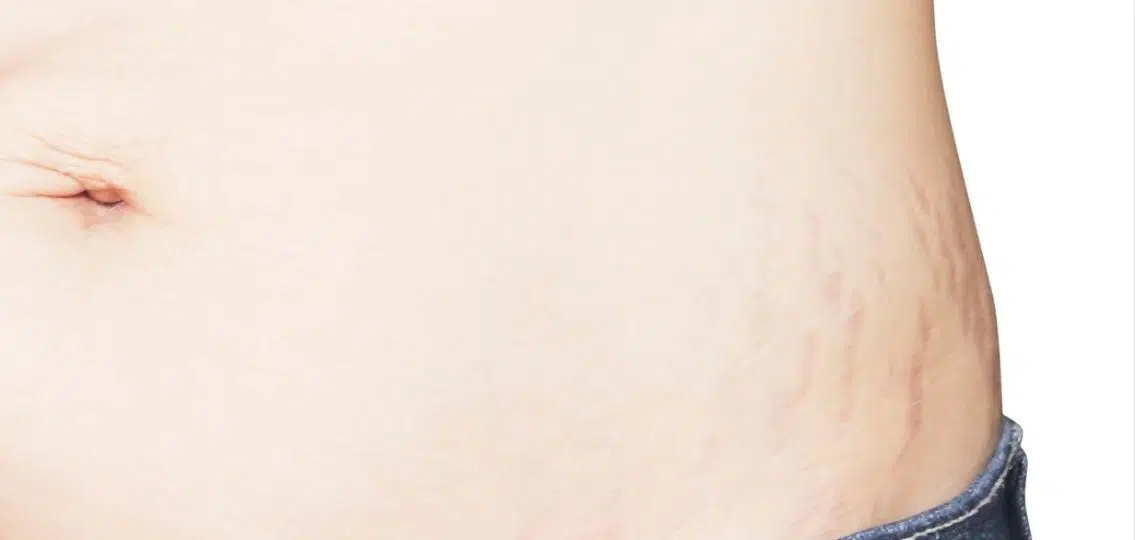Most of us associate stretch marks with girls and women—at least I always have. I have a vivid memory of finding my first stretch marks when I was 11. I had stretch marks virtually everywhere, it seemed, including my shoulders and knees.
But I’d been prepared: My mom had told me what they were, and warned me they ran in our family.
Two decades later, I was greeted with angry red stretch marks across my pregnant belly. I didn’t love these pregnancy “battle scars,” but I expected them, and knew that they’d fade.
I thought I knew all there was to know about stretch marks, but when a friend confided in me recently that her teen son had stretch marks up and down his back, around his hips and along the back of his arms, I was surprised. I knew that teen boys could get stretch marks, but I didn’t realize just how extensive they could be!
My friend’s son had come to her worried that he’d been bruised or hurt in some way. No one had told him what stretch marks were, and my friend felt bad that she hadn’t prepared him.
I have two boys, and I’ll admit that I didn’t even think to prepare them for stretch marks. But considering that stretch marks seem to run in my family, I realized I better learn all I can about stretch marks in teen boys.
I connected with two pediatricians and a dermatologist to answer my questions about stretch marks and boys and to demystify the topic for all of us parents of teen boys.
Are Stretch Marks Common in Teen Boys?
My assumption that stretch marks are mostly a “girl problem” has a sliver of truth. According to Dr. Daniel Ganjian, a pediatrician at Providence Saint John’s Health Center in Santa Monica, CA, teen girls get stretch marks about 70 percent of the time, while teen boys get them about 40 percent of the time.
So yes, they’re more common in girls, but many boys get them too!
Dr. Erum N. Ilyas, a board certified dermatologist, says that he frequently sees stretch marks in teen boys, especially during puberty. However, Dr. Ilyas explains, the way that stretch marks present in boys is often different than in girls.
“In boys, I routinely find stretch marks along the lower back and flanks with increases in vertical height at a fast rate,” he says.
Dr. Erica H. Kates, a pediatrician at Holyoke Pediatric Associates in Massachusetts, sees stretch marks in both her male and female patients.
In genetically male teens, stretch marks usually present as “horizontal stripes on the back,” she says, and correspond with rapid periods of growth. Girls, on the other hand, tend to have stretch marks appear in multiple areas of the body, including breasts, thighs, and hips.
Why Do Teen Boys Get Stretch Marks?
Stretch marks, which are also known as “striae,” happen most often during growth spurts, breast growth, rapid weight gain, and body-building, says Dr. Ganjian.
Technically, says Dr. Ilyas, stretch marks are a form of scar tissue. “When the skin expands faster than it can keep up with, there is initially an inflammatory response followed by a healing phase,” he explains.
Dr. Kates says that stretch marks usually correspond with times of very rapid growth (such as puberty) or during times of rapid weight gain. But this is not always the case, and genetics may play a role in how easily your body will generate stretch marks in times of growth.
“Some people are genetically more prone to get stretch marks, and may get them even with a smaller growth or weight gain,” Dr. Kates clarifies.
Dr. Ilyas explains that the reason some teen boys get stretch marks and others do not is based on both genetics and also how quickly their skin expands. In other words, if stretch marks run in your family, and your son has a rapid growth spurt, you are likely to see some stretch marks crop up.
Reasons For Teenage Stretch Marks on Back?
Stretch marks on the back, particularly in teenagers, are a natural and common occurrence. Understanding why they appear and how to manage them can provide both teenagers and parents with the necessary information and reassurance.
- Rapid Growth Spurts: During adolescence, teenagers often experience growth spurts. The back, being a large area of the body, can grow quickly, stretching the skin beyond its capacity to adapt smoothly. This rapid stretching leads to the formation of stretch marks.
- Hormonal Changes: Puberty brings about hormonal changes that can affect the skin’s elasticity and collagen production. These changes make the skin more susceptible to tearing when stretched, resulting in stretch marks.
- Muscle Growth: Teenagers involved in athletic activities or strength training may develop increased muscle mass rapidly, particularly in the back area. This sudden increase in muscle size can stretch the skin, leading to stretch marks.
- Genetic Factors: Genetics play a significant role. If parents had stretch marks as teenagers, their children might be more likely to develop them.
What Can You Do About Them?
Stretch marks can appear as deep pink or purple lines or can even look like cuts or bruises. Probably the most important thing to remember about stretch marks—besides the fact that they are normal and harmless—is that they do fade in time.
“Stretch marks start as reddish-purple lines, progress to white lines, and then often fade over a few years,” says Dr. Ganjian. He emphasizes that having stretch marks is not a medical problem and you don’t have to do anything about them.
If the appearance of stretch marks bothers your teen, there are things that might help decrease their appearance, including using moisturizers, retinoid creams, and trying laser therapy, says Dr. Ganjian. You should talk to your child’s pediatrician before trying any of these things.
Dr. Kates says that it can sometimes be difficult to completely get rid of stretch marks. But she advises that sunscreen can help minimize their appearance.
How to Talk to Your Son About Stretch Marks
Probably the thing I’m worried about most, should my sons get stretch marks, is helping them navigate their emotions. Puberty is already a difficult time: Having a bunch of deep purple lines suddenly appear on their skin seems like a potentially anxiety-producing situation.
The experts I spoke to say that talking to your teen son about stretch marks is a must. Reassuring them that these marks are normal and will fade in due time can help as well. It’s also possible to reframe the experience as a positive one.
You can tell your son that the stretch marks are a sign of growth and something to be proud of, says Dr. Ganjian. “Let them know how lucky they are to be growing fast,” he says.
“Growing fast comes with cool ‘skid marks’ that do not cause any problems or pain.”
You should also make sure to check your own emotional reactions to what is happening, Dr. Ganjian reminds, as kids can feed off their own parents’ emotions. Make sure your kids know that you feel excited about what the stretch marks signify, and that there is nothing shameful about their appearance.
This is fantastic advice, and I hope to take it to heart. I know from personal experience how valuable it is to be prepared when it comes to stretch marks, and how reassuring it is to know that what is happening is normal, temporary, and maybe even something to celebrate.




